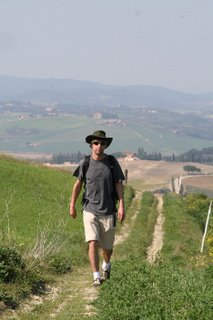We were on the second day of our three-day South Africa safari and participating in a "bush walk". My girlfriend Devon and I were joined by one other couple and our khaki-wearing, rifle-toting guide Jonathan.

Now, seeing an elephant on a safari is a common event. However, this elephant caught us by surprise, ambling towards us from over the horizon as our attention was on a nearby watering hole, our minds speculating whether the water buffalo we were watching would get close enough to the crocodile lurking in the water to create some excitement.
Now, however, our thoughts and eyes were diverted, flicking back and forth from the watering hole to the big full elephant coming for a drink, still far away but certainly impressive with his ears waving like flags in a soft breeze.
The funny thing was, either my geometry was off or the elephant was angling more towards us than the pool. "Now don't get excited", said Jonathan. "But I want all of you to very casually move behind that bush." Clearly, Jonathan's geometry calculation was the same as mine and he was wondering about the elephant's intentions also.
A few more minutes and the distance was closing. The elephant was clearly moving more towards us than the watering hole. "Now, again, I want you to move very casually from behind that bush to this tree", instructed Jonathan. "Get in single file behind the tree and minimize the elephant's view of us." I asked later and Jonathan told me the bush was good for concealing us but the tree made for better protection.

At this point, all of us were at least nervous. Except perhaps Jonathan. Devon was first in line. With her face buried in the tree, she had given up any thought of watching the elephant. I was next, poking my head out to keep on eye on the several tons of flesh ambling on a path that seemed to be directly towards us.
Ultimately, the elephant swerved and headed away from us and towards the pond, passing no more than 20 feet from our tree. We were all relieved and excited and I am sure all of us (except, again, Jonathan) still tell the story over a year later. It was an excellent example of how incredibly memorable a safari can be.
This was the only safari I have done in my life, which seems a little strange in hindsight since I have traveled over much of the world and have been to many places multiple times. I think I had always felt safaris were, well, overrated. A conversation I had just a few days ago confirmed this. I was telling my friend Rob, an avid traveler and outdoors man, about the elephant experience and he listened with a questioning look on his face. "Are safaris really that fun?" he asked.
Safaris are not overrated. They are an incredible experience for everyone ... and you don't have to interact on foot with elephants to enjoy them.
On our scheduled October 2008 South Africa Adventure, we will spend three days and two nights at the Chapungu Bush Lodge in a private reserve near Kruger National Park. The main game viewing is done on bush drives, in a very safe Landrover that allows us to cover long distances and go where the animals are active. These drives are amazing and will rate up there with any vacation you have done.

The foot safaris are offered each afternoon and are entirely optional. Me? I thought the foot safaris were the best part of the experience. I loved being out in the open, knowing I was unlikely to encounter any real danger but still excited at no longer being at the top of the food chain. (It was also nice to get a little exercise.) However, the foot safaris are optional so you can choose to participate or not.
Whatever you decide, you will love the creature comforts of our tented lodge. The meals are superb, the wine flows, the staff is nice beyond what we expect, and the tales we tell at night reflect the incredible sights and experiences we live each day.
P.S. For information on the active wine portion of our South Africa Adventure, see my Travels With Wine blog.
















